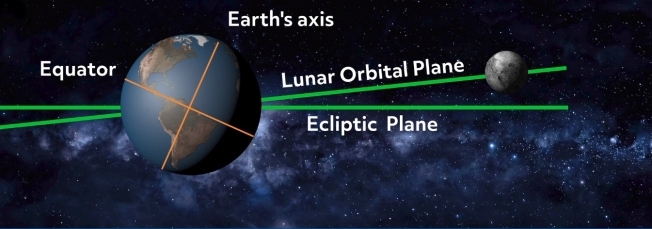
Ancient Views of Eclipses
For thousands of years, humans viewed eclipses as evil omens. In a solar eclipse, the Sun, our source of light and warmth, disappears from the sky without warning. There is no promise that it will reappear. That can be terrifying!
From the Americas to Egypt, many cultures saw the eclipse as proof that the powers of evil and darkness were trying to swallow up the powers of goodness and light. At any moment, the powers of darkness could be successful and the world could end.
In the Inca Empire, a solar eclipse meant the Sun was angry. A lunar eclipse meant the Moon was sick. To reverse a lunar eclipse, dogs would be beaten so that their howling could bring the Moon back.
Thankfully, we now know what causes eclipses, and it is not the evil powers of darkness, nor is it anger and illness. Rather, eclipses are caused by shadows.
Any time an object passes between a light source and another object, an eclipse occurs. On a planetary scale, we are on those objects and either see the shadow cross the other object or are covered by the shadow. We can predict them decades in advance using mathematical models, something that was extremely rare in ancient society.
As far as we know, only the Maya and the Greek were able to predict eclipses in advance. For example, the Mayan Dresden Codex predicted eclipses as early as the 11th century.
Solar Eclipses
There are two main kinds of eclipses: a solar eclipse and a lunar eclipse. The causes are similar but different, so we’ll discuss them one at a time. A total solar eclipse is the most dramatic eclipse. In this eclipse, the Sun is blocked and the day turns to night, though only for a few minutes.
To understand a solar eclipse, you need to know that the Moon orbits the Earth, and the Earth orbits the Sun. The Moon takes about 29 days to go around the Earth, while the Earth takes about 365 days to go around the Sun. As the Earth and Moon continue their dance around the Sun, the Moon will sometimes get right between the Sun and the Earth. From the Earth, we see the Moon block out the Sun.
When something blocks out the Sun, we call the darkness behind it a shadow. Think about a tall building blocking out the Sun. If you are standing on the shady side of the building, you are in the building’s shadow. When the Moon gets between the Earth and the Sun, the Earth is in the Moon’s shadow. The Moon is small compared to the Earth, so it has a small shadow. For this reason, only a tiny piece of the Earth will get to see the light show put on by a total solar eclipse.
There are other kinds of solar eclipses that occur when the Moon and Sun do not line up perfectly.
Partial Eclipse
For instance, if you are not in the path of a total solar eclipse, you may still be able to see a partial eclipse. A partial eclipse occurs when the Moon goes partway in front of the Sun. During a partial eclipse, the Sun resembles a crescent Moon.
Annular Eclipse
If the Moon is a little farther from the Earth during a solar eclipse, another kind of eclipse happens: an annular eclipse. In this eclipse, the Sun can be seen on all sides of the Moon.
Diamond Ring Eclipse
A third appearance of the Sun is called the “diamond ring.” This actually happens twice during a total solar eclipse.
A diamond ring is formed when the Sun is not entirely covered by the Moon. The Moon is a rocky object with valleys and mountains, and the sunlight can shine through one of these valleys, producing a bright spot of light that resembles a jewel.
Lunar Eclipse
A lunar eclipse, on the other hand, can be seen by half the Earth. To understand a lunar eclipse, you need to know that the Moon does not shine with any light of its own that we can see.
The brightness of the Moon we see in the sky is from reflected sunlight. So if the Sun can’t shine on the Moon, we can’t see the Moon. A lunar eclipse is caused by the Moon traveling through the Earth’s shadow. The Earth has a pretty big shadow compared to the Moon, so the Moon takes hours to travel through this shadow.
Blood Moon
When the Moon is fully in the Earth’s shadow, it turns bright red. Sometimes a lunar eclipse is called a blood moon for this reason.
The cause for this red is the Earth’s atmosphere. Even though the Earth has blocked out the Sun itself, it cannot block out the sunlight that comes from the atmosphere. Sunlight looks red when it travels through a lot of atmosphere. This is what makes a sunset look red. The Moon is experiencing sunsets from all around the Earth at the same time, turning it red.
Because the Moon orbits the Earth once a month, you might expect to see both kinds of eclipses every month. You may know from experience, though, that eclipses are more rare than that!
The Moon’s Tilt
So why don’t we see eclipses every month?

The Moon does not orbit the Earth right above the Earth’s equator. If it did, we in fact would see both kinds of eclipse every month. Instead, the Moon’s orbit is tilted. Because of this, we need a perfect alignment to get either kind of eclipse. This alignment occurs about twice a year, causing an “eclipse season”, where we typically get a solar and lunar eclipse within the same month.
If you are not near the Moon’s shadow during a solar eclipse, though, you’re likely to miss it. Remember: the Moon casts a small shadow. You may have to travel to see a solar eclipse. Today, we can predict them very far in advance, so perhaps this will be an option for you.
Even if you can’t travel to see a solar eclipse, you may be on the half of the Earth that gets to see a lunar eclipse! On average, a person can see a lunar eclipse about once a year.
Naming Conventions
How can you keep these two kinds of eclipses straight? One way is to remember that the eclipse is named after the object that is blocked out. In a solar eclipse, we no longer see the Sun. In a lunar eclipse, the Moon dims and turns red. It’s just as important to remember that the cause is shadows, and the shadows are not the ones in the name.
A solar eclipse, where the Sun disappears, is caused by the Moon’s shadow on the Earth. A lunar eclipse, where the Moon turns red, is caused by the Earth’s shadow on the Moon. Notice none of these involve shadows on the Sun. The Sun is the light source for the solar system, so there are never shadows on it.
Sometimes we do see dark spots on the Sun, but this is either a different phenomenon called Sunspots, or a planet moving between us and the Sun, which we call a transit. In a sense, an eclipse is a special type of transit.
Review
In review, when the Sun, Moon, and Earth line up, an eclipse occurs. A solar eclipse is exactly in that order: the Moon is between the Sun and Earth. A lunar eclipse occurs when the lineup is Sun, Earth, and Moon, and the Earth gets between the Sun and the Moon.
That’s all for now, thanks for watching and happy studying!

